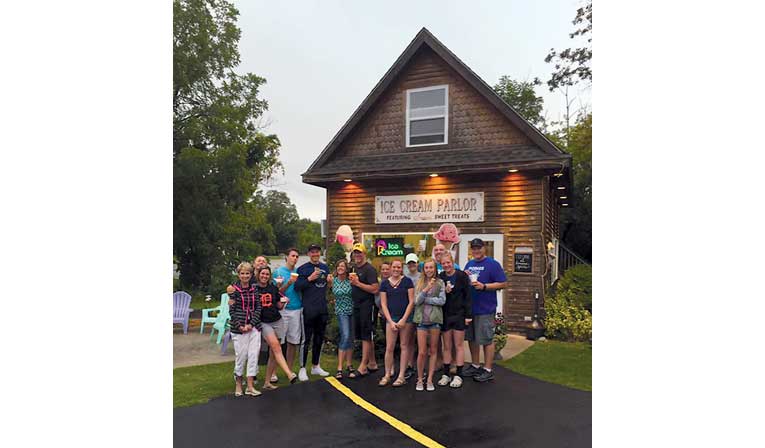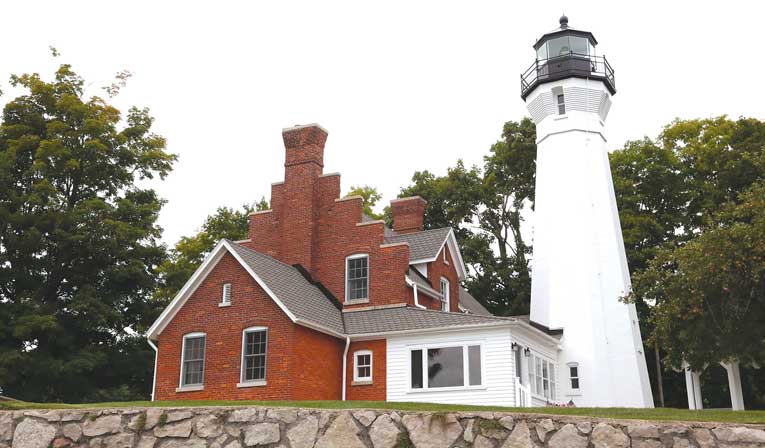Photo Courtesy of Port Sanilac Municipal Harbor
From a swinging bridge, underwater shipwreck preserve and the state’s oldest hardware store to festivals, fireworks and old-fashioned fun, Michigan’s Thumb region of Lexington and Port Sanilac beckons boaters.
For Paul Hampton and his wife, Lydia, summer doesn’t get much better than cruising on Lake Huron or chilling dockside aboard their 23-foot Sea Ray at the Lexington marina, just 90 minutes from their metro Detroit home.
In this boating haven on Michigan’s eastern shore, stress fades away as the couple sips drinks, grills burgers and watches the goings-on in the bustling port, a state-designated Harbor of Refuge that Hampton describes as “well-sheltered and well-managed.” Featuring a limestone breakwall and half-mile-long pier, the marina is a quick stroll to the village of Lexington’s quaint downtown, with its charming mix of shops, restaurants, theater and pubs, including the Lexington Brewery and Wine House in a restored fire hall.
“Lexington’s a great little town. Everything is very convenient — you just walk up from the harbor and the downtown is right there,” says Hampton, a business owner and grandfather, whose family enjoys the Lexington General Store’s old-fashioned candy counter, free Friday night concerts in the park near the marina and Independence Day weekend fireworks (scheduled July 5 this year). “Sitting on the boat in the harbor and watching the fireworks, you are literally right under it. It’s a spectacular show.”
Eleven shoreline miles north, in the quiet village of Port Sanilac (population 584), boaters also give high marks to another Harbor of Refuge that’s popular with sailors, Port Sanilac Municipal Harbor.
“We get lots of sailboats; we have a lot of depth in this harbor,” says Harbormaster Vanessa Stewart. “Any boat that draws more than 6 feet, we can accommodate them.”
Recreation central
With a rich lumbering, maritime and agricultural history, family-friendly attractions, special events and a laid-back vibe, Lexington and Port Sanilac combine to make Michigan’s Thumb region (as it’s known) an attractive getaway for boaters along the western shore of Lake Huron. Touting itself as “the first resort north,” Lexington is located 23 miles north of Port Huron, where the lake channels into the St. Clair River.
The Thumb, with its relatively low profile, “has a lot going for it,” says Nadine Maliniak, innkeeper at A Night to Remember, a popular Lexington B&B with an ice cream parlor, Temptations, next door. “It feels like you’re up north but not as busy as some of the resort towns where it’s super crowded and you can’t get into the restaurants and stores. It’s great for anyone who enjoys getting away from the hustle and bustle.”
And, Maliniak adds, the Lexington and Port Sanilac harbors, with white-sand public beaches next to them, “are just beautiful.”
The harbors function as recreation central. In addition to full- service public and private marinas, boaters will find parks, picnic tables, grills, rental kayaks, fishing and dive charter boats, and other amenities. The dive boats offer excursions to wreck sites in Sanilac Shores Underwater Preserve, a 163-square-mile shipwreck-studded marine sanctuary that stretches from near Lexington to Forestville, 16.5 miles north of Port Sanilac (see sidebar).
For landlubbers, several area golf courses welcome boaters, including the 18-hole Huron Shores Golf Club, three miles north of Port Sanilac, with a remodeled clubhouse and restaurant with outdoor deck. In Lexington, less than two miles from the harbor, Lakeview Hills Golf Resort boasts two 18-hole courses, a hotel, restaurant, 16-lane bowling alley, health club and free shuttle service from the marina.

Photo Courtesy of Temptations Facebook
Shipwreck Mecca
 Unless you have a diver aboard, you might cruise over the 163-square-mile Sanilac Shores Underwater Preserve in Lake Huron without giving it much thought.
Unless you have a diver aboard, you might cruise over the 163-square-mile Sanilac Shores Underwater Preserve in Lake Huron without giving it much thought.
But this area of Michigan’s Thumb, stretching from near Lexington to north of Port Sanilac, is a Great Lakes graveyard for nearly two dozen shipwrecks. Some 16 of them lie within recreational diving limits — above 120 feet — making this a Mecca for sport divers.
Many of the ships fell victim to rough seas, accidents, collisions and storms, including the notorious Great Storm of 1913 — so ferocious it was called the “White Hurricane,” the “Frozen Fury” and the “Big Blow.” It was the Great Lakes’ worst recorded disaster, and Lake Huron was especially hard hit.
Regina is one of Lake Huron’s most famous casualties. The steel-hulled steamer went missing with all 25 hands on November 9, 1913, and wasn’t discovered until 1986. Resting almost midway between Lexington and Port Sanilac, the 250-foot-long freighter is among the preserve’s most popular dive sites. It sits upside down on the lake bottom in 80 feet of water, and the bottom of its hull can be reached at 25 feet.
Even closer to Lexington, another favorite is Sport, the first steel tug on the Great Lakes. It’s also the first Michigan shipwreck on which divers placed a Michigan Historical Marker. The 57-foot vessel, built in 1873, was no match for a severe gale on December 13, 1920. Resting in 45 feet of water, today Sport rises up about 20 feet off the bottom, intact with many tools and relics scattered about the site.
Several dive charters at both the Lexington and Port Sanilac harbors offer guided excursions to the preserve’s many wreck sites.
Visit michiganpreserves.org/sanilac.htm for more information.
Photo Courtesy of Sanilac Shores Underwater Preserve Facebook/Divers Incorporated
Photo Courtesy of Museum Website
A storied village
Early settlers were drawn to Michigan’s heavily forested Thumb, and lumbering grew into a major industry. Among Port Sanilac’s pioneering lumberjacks was a group that cut and peeled hemlock bark used for leather tanning and shingles. Their bark-covered shanty out on the point became a local landmark. By the 1830s, it gave rise to the village’s original name, Bark Shanty Point, which was later changed to honor a Native American chief, Sanilac.
South of the marina, historic Port Sanilac Lighthouse, which burned kerosene from 1886 until its electrification in 1924, still stands. Though it’s now a private residence, tours are sometimes available through the Sanilac County Historic Village and Museum, a must-see for history buffs.
Located within walking distance of the harbor, the 10-acre historic village is a collection of a dozen historic buildings anchored by a grand, Second Empire-style mansion turned museum. Originally clad in a white-yellow brick that was barged across Lake Huron from Ontario, it was built in the early 1870s by the town’s horse-and-buggy physician, Dr. Joseph Loop.
Tours of the Loop-Harrison House and the entire grounds are offered twice daily from Memorial Day through Labor Day weekends and showcase period furniture, marine and shipwreck items, military memorabilia and Native American artifacts. Outside, buildings range from a two-room Victorian privy to a centennial schoolhouse, turn-of-the-century general store and a church that started life as a tavern.
The Loop family’s 1880s-era barn now houses Port Sanilac’s “come as you are” Barn Theatre with a summer schedule of live shows, including comedies, musicals, concerts and dramas — some geared for adults, others family fare.
In a real life drama, the doctor’s daughter who was a piano teacher, Ada Harrison, died tragically in 1925 in Sanilac County’s first automobile fatality. Blinded by the lights of a car as she walked across the highway in front of her home, she was struck by a second car, a Model T without working headlights. Ada’s ghost is said to haunt the grounds.
Port Sanilac’s sleepy downtown is home to a handful of browse-worthy shops, including East Port Exchange, with gifts, antiques and works by local artists, as well as Michigan’s oldest operating hardware store. From humble beginnings on stilts in 1850, Raymond Hardware grew into a full-service destination hardware and lumber yard; you can even get a Michigan fishing license there.
Nearby, Stone Lodge, a rustic, north-woods restaurant, draws rave reviews for its homemade chicken pot pie, portobello fries, lake perch and key lime pie. The Portly Pig, with a new backyard mini-golf course, makes a mean pulled pork-topped cornbread pancake with house-made coleslaw, among other barbecue specialties. For beautiful harbor views, try The View at Uri’s Landing on the second floor of the marina.
Among Harbor Park events this summer is the Port Sanilac Blues Festival August 2-3; the Antique Boat and Vintage Festival August 16-17; and Saturday night “Music at the Harbor” concerts.

Photo Courtesy of Sanilac Municiapal Harbor Facebook
From lumber to Lexington
With a population of 1,178, Lexington remains a center of Thumb activity, just as it was in the mid-1800s when the forests were being harvested. Steamships and freighters stopped regularly for lumber and agricultural products until the infamous Great Storm of 1913 destroyed the village’s long dock into Lake Huron.
Today, Lexington’s many Victorian homes, vintage B&Bs and historic downtown buildings housing shops and restaurants recall the lumber barons, carpenters and woodworkers who once lived there. Originally called Greenbush, the village was renamed in 1846 after the Battle of Lexington in Massachusetts by a settler whose wife’s cousin was the Revolutionary War patriot Ethan Allen.
These days, the town is buzzing about the spiffy, $3.5-million restoration and reopening of the historic Cadillac House Inn & Tavern, a community anchor since 1860. It offers 12 tastefully decorated rooms, two balcony suites and a restaurant known for its northern fish chowder, smoked whitefish spread, cheddar biscuits with butter and apple butter, and butterscotch pie.
Grab a table overlooking the harbor on the deck of The Windjammer Restaurant & Bar and order drinks such as the Lake Huron Long Island or Lexington Lemonade with pomegranate juice, strawberries, raspberries and vodka. The menu includes blue cheese nachos, soups and chowders, steaks, seafood and pasta; don’t miss the chocolate mousse cake and other from-scratch desserts.
There’s no shortage of entertainment and special events in Lexington, including the third annual Boat Show, this year July 13, sponsored by the Antique & Classic Boat Society Michigan Chapter, and the popular Lexington Lakeside Craft Fair, this year June 15-16.
The free Friday night concert series in the park, typically mid-June to mid-August, is a major summertime draw, while the Lexington Village Theatre stages regular performances, from comedians and the Glenn Miller Orchestra to Jeff Daniels and the Ben Daniels Band.
Thousands of visitors flock to Lexington each August for the Fine Arts and Crafts Street Fair, with more than 150 artists (this year August 3-4), and the Jimmy Buffett-inspired Margarita Fest (this year August 23-24).
Summer’s end in Lexington brings Thumbfest, a free, one-day folk and traditional music extravaganza hosted by the Blue Water Folk Society (typically the Saturday of Labor Day weekend), and the Lexington Bach Festival’s weekend of concerts (in mid-September).
Less than six miles inland from Lexington, and easily accessed by a bike trail, the Croswell Swinging Bridge is a local institution. Built in 1905 over the Black River, the suspension footbridge has a folksy sign on one end advising pedestrians to “Be Good to Your Mother-in-Law.” Kids enjoy cooling off at the splash pad in the park. Underscoring the region’s agricultural heritage (sugar beets are a major crop), Croswell is also home to the iconic Pioneer Sugar plant.
History: The Great Thumb Fire
Even before the Great Storm of 1913 came, the Great Thumb Fire of 1881 killed 282 people in Sanilac and three surrounding counties.
So much soot and ash shot up into the atmosphere that sunlight was partially obscured in locations as far away as New England, where the sky appeared yellow and projected a strange luminosity onto buildings and vegetation. September 12, when twilight appeared at noon, was dubbed “Yellow Tuesday” thanks to this odd atmospheric event.
Interestingly, response to the Great Thumb Fire was the first official disaster relief operation by the American Red Cross, which was founded the same year by Clara Barton. The organization provided money, clothes and household items to devastated Thumb-area residents.
Native American Petroglyphs
 Some 40 miles from the Port Sanilac harbor, Sanilac Petroglyphs Historic State Park is Michigan’s only known rock carvings attributable to Native Americans. History interpreters may be present during limited park hours to give tours of the rocks, which otherwise are fenced-in to protect the fragile carvings etched in sandstone. Admission is free, but a Michigan Recreation Passport is required for vehicles. Best bet is to call ahead for information and hours (989- 856-4411).
Some 40 miles from the Port Sanilac harbor, Sanilac Petroglyphs Historic State Park is Michigan’s only known rock carvings attributable to Native Americans. History interpreters may be present during limited park hours to give tours of the rocks, which otherwise are fenced-in to protect the fragile carvings etched in sandstone. Admission is free, but a Michigan Recreation Passport is required for vehicles. Best bet is to call ahead for information and hours (989- 856-4411).
Photo Courtesy of DNR


